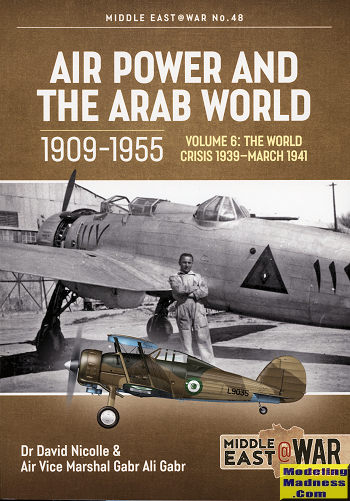 Continuing
with their series on air power in the Arab world, this volume concentrates on
the 1939-March 1941 time frame. This is when Europe went to war and it was
unsure how some of the middle east nations would react to the situation. To be
fair, much of the middle east and north Africa were under the control of
European nations to some extent or another. Only a few were independent enough
to have their own air arms. Those nations were Iraq, Egypt and Saudi Arabia.
Continuing
with their series on air power in the Arab world, this volume concentrates on
the 1939-March 1941 time frame. This is when Europe went to war and it was
unsure how some of the middle east nations would react to the situation. To be
fair, much of the middle east and north Africa were under the control of
European nations to some extent or another. Only a few were independent enough
to have their own air arms. Those nations were Iraq, Egypt and Saudi Arabia.
Saudi Arabia's air force, such as it was, was very
minimalist and their aircraft rarely flew during WWII. This was as much due to a
lack of trained personnel and spares as much as anything else. Iraq had a fairly
large air force, consisting of a goodly number of Italian and British aircraft,
but for the most part, during the time period of this volume, were busy with
internal issues and did not play a part in the conflict. What was true was that
there was plenty of anti-British sentiment, and the British did maintain a large
training establishment at Habbiniya.
That leaves Egypt and the majority of this edition is
concerned with this air arm during the early years of the war. Despite pressure
to declare war on Germany, Egypt remained technically neutral until near the end
of the war. However, the nation was not immune to the conflict. This was
especially true when Italy declared war in June 1940. They began both air and
ground attacks against Egyptian and British targets in Egypt, especially the
British air and naval bases along with the oil refineries in Suez.
Unfortunately, the Egyptians were unable to do much
about the situation in the air. Their air arm was equipped with obsolescent
types such as Gladiators, Audaxes, and a few Ansons. Promised modern types like
Blenheims were never delivered and it wasn't until early 1941 that a few second
hand Hurricane Is were delivered. Much of the Egyptian Air Force was used for
patrolling, point defense, and training. However, thanks to their lack of modern
equipment, raiding Italian, and later German planes were too fast and able to
evade interception. This left it up to the Egyptian anti-aircraft forces (which
were actually quite good) to claim any enemy aircraft.
The research of the authors is first rate, and much is
learned from the log books of several Egyptian pilots of the day as well as
first hand accounts. It tells of a force that was constantly undersupplied and
of some of whose members were quite political, something that seems to be
endemic with Arab air arms. It also shows that these men were good at their job
and not the slackers that is often portrayed in western media. They simply did
not have the tools needed to properly do the job.
This makes for a superb read and one of the best of the
series. The work of the Egyptian Air Force during this time is often dismissed
and it is through this book that we can see what they had to deal with. As usual
with this series there are some superb period photos and a center section of
full color profiles and maps. A book that I very much enjoyed reading and one
that I'm sure you will like as well.
October 2022
Copyright ModelingMadness.com. All rights reserved. No
reproduction in part or in whole without express permission.
Review book courtesy of
Casemate Publishers, where you can order your copy
at this
link.
If you would like your product reviewed fairly and
fairly quickly, please
contact
the editor or see other details in the
Note to
Contributors.
 Continuing
with their series on air power in the Arab world, this volume concentrates on
the 1939-March 1941 time frame. This is when Europe went to war and it was
unsure how some of the middle east nations would react to the situation. To be
fair, much of the middle east and north Africa were under the control of
European nations to some extent or another. Only a few were independent enough
to have their own air arms. Those nations were Iraq, Egypt and Saudi Arabia.
Continuing
with their series on air power in the Arab world, this volume concentrates on
the 1939-March 1941 time frame. This is when Europe went to war and it was
unsure how some of the middle east nations would react to the situation. To be
fair, much of the middle east and north Africa were under the control of
European nations to some extent or another. Only a few were independent enough
to have their own air arms. Those nations were Iraq, Egypt and Saudi Arabia.